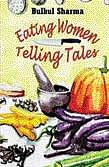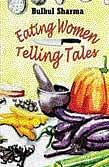
Indian women are among the most creative and elaborate cooks in the world. Bulbul Sharma brings us a rich feast of delectable tales taking off from but by no means restricted by, the theme of food. As the crows circle waiting for the late Shri Bhanurai Jog’s funeral feast to begin, the women of the clan gather in preparation. These women are ordinary; their simple lives revolving around the kitchen and home. Yet while their hands continue to chop and clean, they narrate powerful stories of malice, love, revenge, simmering anger, and every nuance of myriad human emotions.
Badibua begins with the story of spirited and enchanting Maya, whose vicious mother-in-law compels her to pluck with her own hands the basil, mango, ginger and coriander for chutney intended to smother her spirit. Her mother-in-law, eyes glittering with malice, takes Maya to the lascivious village godman, a man who has violently subdued many a woman of the village. Maya’s silver eyes fade into a gentle deadness. Yet her spirit manages to overcome the horrors of the godman with her last thrust of strength.
Jamini’s only son, sullen and self-absorbed Babu, arrives from the USA and finds fault with everything. Jamini, her maternal heart bleeding in the emptiness of her kitchen, passionately pours her affection into food in a desperate attempt to win back Babu’s love. Childless Soni’s is a tale of illicit love and jealousy.
Turning away from her older husband Jogen’s “clumsy fumbling,” she pines for her neighbour Dhani, the butcher. Jealous of Dhani’s wife’s pregnancy, Soni makes a special halwa for her, pouring her rage and frustration into a mix of pure ghee, almonds, dates and raisins, and some chilli powder disguised by extra sugar. Soni’s prayers for a miscarriage result in an ironic twist. Dhani’s wife delivers a healthy girl and thanks Soni for her kindness. And the new baby is credited with bringing the family prosperity and the promise of a child growing in Soni’s womb.
One of the most poignant stories is of the spurned wife Sona, who associates a different scent with each new woman her husband beds. She shops desperately in a bid to feel better, and helps herself to money and knick-knacks as though to make it up to herself for her husband’s betrayal. “The only thing he likes about me now is my cooking, so I will not give that up,” she avers.
These lovely stories can be read and enjoyed many times over. There appear to be some minor anomalies regarding the origins of the characters and the foods they are associated with. For example, Savitri is a relative of Bhanurai Jog. The names and details of his funeral feast strongly suggest a family from the northern heartland. But Savitri’s late husband hailed from West Bengal, and she tells how she once prepared the best bhog and sinni. “Pulao for Durga Ashtami, khitchree for saptami, paish for navami and then meat for kalipuja,” she reminisces about Bengali festivals and traditions. In Sharada’s story, Masi, the daughter of a Raibahadur from the Tripathi clan (suggesting UP or Bihar), discusses the preparation of chana paishe and eats prawns, which are more typically popular further east in Bengal, Orissa etc. Pinning down these characters and their cuisines more precisely to specific regions of our country would have further enriched these enchanting stories.
